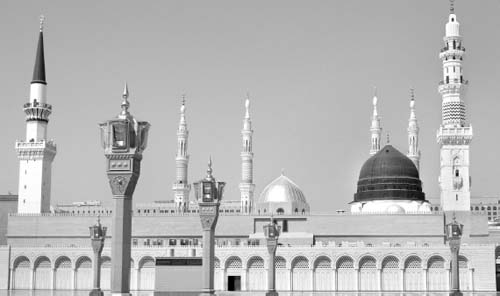IslamSigns and Symbols |
Do Muslims mark their sacred spaces with any distinctive signs and symbols? |
Drive by the mosque nearest you—there is probably one not very far away—and you are likely to notice two distinctive features. Attached to, or alongside, the building you will see one or perhaps two slender towers called minarets. Originally designed to provide maximum broadcast of the call to prayer, the minaret eventually became a visual symbol of Islamic presence. Most structures designed as mosques feature a dome of some sort, typically spanning the central interior space called the prayer hall. Many synagogues and Eastern Christian churches also use central domes, but generally do not have towers that one might mistake for minarets. Atop some minarets and domes you will find a finial in the shape of a crescent moon encircling a single star.
Some communities choose to have their mosques reflect architecturally a particular national or regional heritage. They might hire, for example, an Egyptian architect to design in a neo-classical Egyptian style, as with the national mosque in Washington, D.C. Or they might choose to incorporate some visual allusion to a particularly important mosque, the way the new Islamic Center of Cleveland aligns a large central and a smaller secondary dome, recalling the Dome of the Rock and Al-Aqsa mosque in Jerusalem.
Interior decorations typically feature elegant calligraphic texts, either painted or carved in marble or other stone, of the names Allah and Muhammad, and of the Shahada and Basmallah (“In the name of God …”), and possibly of any number of the “Ninety-Nine Beautiful Names” of God. Calligraphic decoration often appears around the drum of the dome and around the niche on the wall facing Mecca. Prayer rugs or carpeting sometimes show designs of niches like that of the mihrab (pronounced mihRAAB, niche). And somewhere in the mosque there will more than likely be a large picture of the sanctuary of the Ka’ba in Mecca, and possibly also of the Prophet’s mosque in Medina.

The Prophet’s mosque in Medina. The large dark (green) dome at right marks the grave of the Prophet.
